Related Research Articles

The Cutler Majestic Theatre at Emerson College, in Boston, Massachusetts, is a 1903 Beaux Arts style theater, designed by the architect John Galen Howard. Originally built for theatre, it was one of three theaters commissioned in Boston by Eben Dyer Jordan, son of the founder of Jordan Marsh, a Boston-based chain of department stores. The Majestic was converted to accommodate vaudeville shows in the 1920s and eventually into a movie house in 1956 by Sack Cinemas. The change to film came with renovations that transformed the lobby and covered up much of John Galen Howard's original Beaux-Arts architecture.
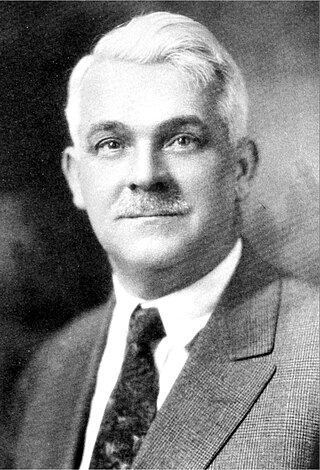
Thomas White Lamb was a Scottish-born, American architect. He was one of the foremost designers of theaters and cinemas of the 20th century.

Benjamin Franklin Keith was an American vaudeville theater owner, who played an important role in the evolution of variety theater into vaudeville.

Edward Franklin Albee II was an American vaudeville impresario.
The Keith-Albee-Orpheum Corporation was the owner of a chain of vaudeville and motion picture theatres. It was formed by the merger of the holdings of Benjamin Franklin Keith and Edward Franklin Albee II and Martin Beck's Orpheum Circuit.

Martin Beck was a vaudeville theatre owner and manager, and theatrical booking agent, who founded the Orpheum Circuit, and built the Palace and Martin Beck Theatres in New York City's Broadway Theatre District. He was a booking agent for, and became a close personal friend of the prominent magician, Harry Houdini.

The Keith-Albee Theatre is a performing arts center, located across the street from the Frederick Building in downtown Huntington, West Virginia, United States.

The Palace Theatre is a 2,695-seat restored movie palace located at 34 W. Broad Street in Columbus, Ohio. It was designed and built in 1926 by the American architect Thomas W. Lamb as part of the American Insurance Union Citadel. Today the theater functions as a multi-use performing arts venue. It is owned and operated by The Columbus Association for the Performing Arts. The Palace Theater's "house" is considered separate from LeVeque Tower, while the marquee and lobby are part of the LeVeque complex.

The Boston Opera House, also known as the Citizens Bank Opera House, is a performing arts and esports venue located at 539 Washington St. in Boston, Massachusetts. It was originally built as the B.F. Keith Memorial Theatre, a movie palace in the Keith-Albee chain. The chain became part of RKO when it was established just before the theater opened on October 29, 1928, and it was also known as the RKO Keith's Theater. After operating for more than 50 years as a movie theater, it was rededicated in 1980 as a home for the Opera Company of Boston, which performed there until the opera company closed down in 1990 due to financial problems. The theater was reopened in 2004 after a major restoration, and it currently serves as the home of the Boston Ballet and also hosts touring Broadway shows.
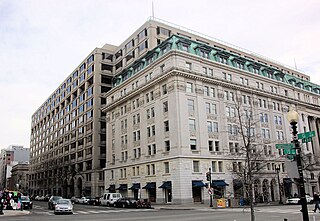
The Chase's Theater and Riggs Building, also known as the Keith-Albee Theater and the Keith-Albee Building, was a historic building located at 1426 G Street and 615-627 15th Street, Northwest, Washington, D.C., in the city's Downtown area.

The Park Theatre (est.1879) was a playhouse in Boston, Massachusetts, in the late 19th and early 20th centuries. It later became the State cinema. Located on Washington Street, near Boylston Street, the building existed until 1990.

The Globe Theatre (est.1871) was a playhouse in Boston, Massachusetts, in the 19th century. It was located at 598 Washington Street, near the corner of Essex Street. Arthur Cheney oversaw the Globe until 1876. From 1871 to 1873 it occupied the former theatre of John H. Selwyn. After a fire in May 1873, the Globe re-opened on the same site in December 1874. Architect Benjamin F. Dwight designed the new building. From 1877 to 1893 John Stetson served as proprietor; some regarded him as "a theatrical producer with a reputation for illiteracy in his day such as Samuel Goldwyn has achieved" in the 1960s. The theatre burned down in January 1894.

B.F. Keith's Theatre (1894–1928) in Boston, Massachusetts, was a vaudeville playhouse run by B.F. Keith. It sat across from Boston Common in the city's theatre district, with an entrance on Tremont Street and another on Washington Street. Personnel included Keith, E.F. Albee and H.E. Gustin. Virgilio Tojetti painted some of the interior decorations. In 1939, the theater was converted to a movie theater named the Normandie.

Selwyn's Theatre (1867–1870) of Boston, Massachusetts, was established by British-born actor John H. Selwyn. Architect Benjamin F. Dwight designed the building. Personnel included Dexter H. Follet, Arthur Cheney, H.A. M'Glenen, Charles R. Thorne Jr., and Charles Koppitz. In 1871 Selwyn's was renamed the "Globe Theatre."
The St. James Theatre (1912–1929) of Boston, Massachusetts, was a playhouse and cinema in the Back Bay in the 1910s and 1920s. It occupied the former Chickering Hall on Huntington Avenue near Massachusetts Avenue, adjacent to Horticultural Hall. For some years Loew's theatre chain oversaw the St. James. In 1929 the theatre "became part of the Publix (Paramount) chain, and was renamed the Uptown."
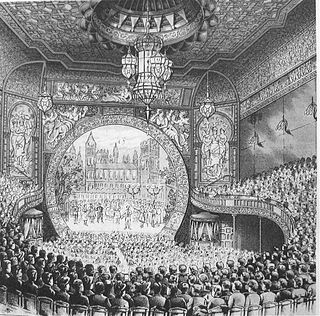
The Bijou Theatre (1882–1943) in Boston, Massachusetts, occupied the second floor of 545 Washington Street near today's Theatre District. Architect George Wetherell designed the space, described by a contemporary reviewer as "dainty." Proprietors included Edward Hastings, George Tyler, and B.F. Keith. Around the 1900s, it featured a "staircase of heavy glass under which flowed an illuminated waterfall." The Bijou "closed 31 December 1943 and was razed in 1951." The building's facade still exists. It is currently a pending Boston Landmark by the Boston Landmarks Commission.
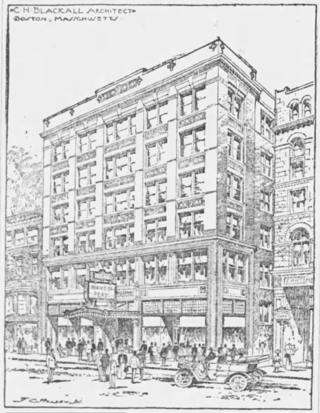
The Gaiety Theatre (1908–1949) or Gayety Theatre of Boston, Massachusetts, was located at no.661 Washington Street near Boylston Street in today's Boston Theater District. The theatre was designed by architect Clarence H. Blackall. The Lyceum Theatre was demolished in June 1908 to make way for the Gaiety Theatre which was built on the same site.
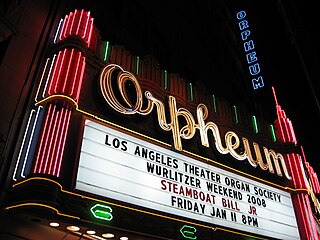
The Orpheum Circuit was a chain of vaudeville and movie theaters. It was founded in 1886, and operated through 1927 when it was merged into the Keith-Albee-Orpheum corporation, ultimately becoming part of the Radio-Keith-Orpheum (RKO) corporation.
The Vaudeville Managers Association (VMA) was a cartel of managers of American vaudeville theaters established in 1900, dominated by the Boston-based Keith-Albee chain. Soon afterwards the Western Vaudeville Managers Association (WVMA) was formed as a cartel of theater owners in Chicago and the west, dominated by the Orpheum Circuit. Although rivals, the two organizations collaborated in booking acts and dealing with the performers' union, the White Rats. By 1913 Edward Franklin Albee II had effective control over both the VMA and WVMA. In the 1920s vaudeville went into decline, unable to compete with film. In 1927 the Keith-Albee and Orpheum chains merged. The next year they became part of RKO Pictures.

The B. F. Keith Circuit was a chain of vaudeville theaters in the United States and Canada owned by Benjamin Franklin Keith for the acts that he booked. Known for a time as the United Booking Office, and under various other names, the circuit was managed by Edward Franklin Albee, who gained control of it in 1918, following the death of Keith's son A. Paul Keith.
References
- ↑ Elliot Norton (1978), Broadway Down East: an informal account of the plays, players, and playhouses of Boston from Puritan times to the present : lectures delivered for the National Endowment for the Humanities, Boston Public Library Learning Library Program, Boston: Trustees of the Public Library of the City of Boston, ISBN 0-89073-055-5, OCLC 3843437, OL 4720054M, 0890730555
- 1 2 Donald C. King (2005), The Theatres of Boston: a Stage and Screen History, Jefferson, N.C: McFarland & Co., ISBN 0-7864-1910-5, OL 3392044M, 0786419105
- 1 2 After the RKO-Boston closed, "Cinerama came in Christmas week of 1953 and stayed until around 1969." (CinemaTreasures.org. RKO Boston Theatre, 614 Washington Street, Boston, MA 02111. Retrieved March 6, 2012)
- ↑ Anthony J. Yudis. "Lafayette Place inspires revitalization; 5 old buildings in lower Washington Street marked for rehabilitation." Boston Globe, November 28, 1982
- ↑ Frank Cullen; Florence Hackman; Donald McNeilly (2004). Vaudeville old & new: an encyclopedia of variety performances in America. Psychology Press. pp. 17–. ISBN 978-0-415-93853-2.
- ↑ Ernie Santosuosso. "Big bands then and now fans danced in the aisles." Boston Globe, November 22, 1987: 117
- ↑ (Additional environmental data: construction of new federal office building, Boston, Suffolk county, Massachusetts, 1979, OL 24162180M )